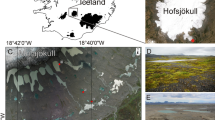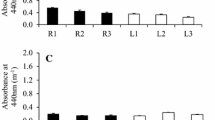We studied changes in the epilimnetic bacterial community composition (BCC), bacterial biomass and production, and protistan succession and bacterivory along the longitudinal axis of the canyon-shaped, highly eutrophic Sau Reservoir (NE Spain) during two sampling campaigns, in April and July 1997. Longitudinal changes in BCC from the river inflow to the dam area of the reservoir were detected by using oligonucleotide probes targeted to the kingdom Bacteria, to the alpha, beta, and gamma subclasses (ALFA, BETA, and GAMA) of the class Proteobacteria, and to the Cytophaga/Flavobacterium (CF) cluster. In general, the inflow of the organically loaded Ter river, with highly abundant allochthonous bacterial populations, induced a clearly distinguishable longitudinal succession of the structure of the microbial food web. The most dynamic changes in microbial parameters occurred at the plunge point, the mixing area of river water and the reservoir epilimnion. Changes within members of BETA and CF were the most important in determining changes in BCC, bacterial abundance and biomass. Much less relevant changes occurred within the less abundant ALFA and GAMA bacteria. From the plunge point downstream, we described a significant shift in BCC in the form of decreased proportions of BETA and CF. This shift spatially coincided with the highest values of heterotrophic nanoflagellate bacterivory (roughly doubled the bacterial production). CF numerically dominated throughout the reservoir without any marked longitudinal changes in their mean cell volume. In contrast, very large cells affiliated to BETA clearly dominated in the allochthonous bacterial biomass brought by the river. BETA showed a marked downstream trend of decreasing mean cell volume. We conclude that the observed BCC shift and the longitudinal shift in food web structure (bacteria-heterotrophic nanoflagellates-ciliates) resulted from highly complex interactions brought about by several major factors: varying hydrology, the high localized allochthonous input of organic matter brought by the river, downstream changing substrate availability, and selective protistan bacterivory.
Similar content being viewed by others
Author information
Authors and Affiliations
Rights and permissions
About this article
Cite this article
Šimek, K., Armengol, J., Comerma, M. et al. Changes in the Epilimnetic Bacterial Community Composition, Production, and Protist-Induced Mortality along the Longitudinal Axis of a Highly Eutrophic Reservoir. Microb Ecol 42, 359–371 (2001). https://doi.org/10.1007/s00248-001-0014-z
Received:
Accepted:
Issue Date:
DOI: https://doi.org/10.1007/s00248-001-0014-z




